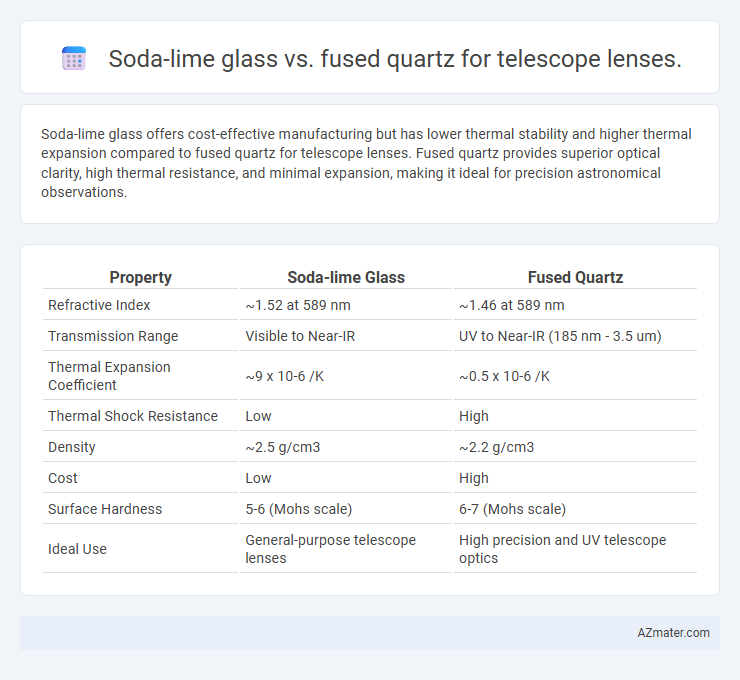Soda-lime glass offers cost-effective manufacturing but has lower thermal stability and higher thermal expansion compared to fused quartz for telescope lenses. Fused quartz provides superior optical clarity, high thermal resistance, and minimal expansion, making it ideal for precision astronomical observations.
Table of Comparison
| Property | Soda-lime Glass | Fused Quartz |
|---|---|---|
| Refractive Index | ~1.52 at 589 nm | ~1.46 at 589 nm |
| Transmission Range | Visible to Near-IR | UV to Near-IR (185 nm - 3.5 um) |
| Thermal Expansion Coefficient | ~9 x 10-6 /K | ~0.5 x 10-6 /K |
| Thermal Shock Resistance | Low | High |
| Density | ~2.5 g/cm3 | ~2.2 g/cm3 |
| Cost | Low | High |
| Surface Hardness | 5-6 (Mohs scale) | 6-7 (Mohs scale) |
| Ideal Use | General-purpose telescope lenses | High precision and UV telescope optics |
Introduction: Significance of Lens Material in Telescopes
Soda-lime glass and fused quartz differ significantly in thermal expansion, transmission, and durability, crucial for telescope lens performance. Fused quartz offers superior ultraviolet and infrared transmission with minimal thermal expansion, enhancing image clarity in varying temperatures. Soda-lime glass, while more affordable, exhibits higher thermal expansion and reduced spectral transmission, potentially compromising optical precision in high-performance telescopes.
Soda-Lime Glass: Composition and Properties
Soda-lime glass, primarily composed of silica (SiO2), soda (Na2O), and lime (CaO), is widely used for telescope lenses due to its affordability and ease of manufacturing. Its optical properties include moderate refractive index around 1.5 and low dispersion, making it suitable for general-purpose lenses but less optimal for high-precision astronomy where chromatic aberration must be minimized. Soda-lime glass exhibits good mechanical strength and thermal stability but has higher thermal expansion compared to fused quartz, impacting performance in temperature-sensitive telescope applications.
Fused Quartz: Composition and Properties
Fused quartz, composed primarily of high-purity silicon dioxide (SiO2), offers exceptional thermal stability and low thermal expansion, making it ideal for telescope lenses exposed to varying temperatures. Unlike soda-lime glass, fused quartz exhibits superior optical transparency across ultraviolet to infrared wavelengths and resists chemical corrosion and devitrification. These properties enable fused quartz lenses to maintain precise shape and clarity, enhancing image quality in high-performance telescopes.
Optical Clarity Comparison
Fused quartz exhibits superior optical clarity compared to soda-lime glass, with lower refractive index and minimal inclusions, resulting in reduced light scattering and higher transmission across ultraviolet to infrared wavelengths. Soda-lime glass contains more impurities and microscopic bubbles that degrade image sharpness and contrast, making it less suitable for high-precision telescope lenses. Fused quartz's homogeneity and durability provide better performance in maintaining optical clarity under varying environmental conditions.
Thermal Expansion and Temperature Stability
Soda-lime glass exhibits higher thermal expansion rates around 9 x 10^-6 /degC, causing significant dimensional changes and optical distortions in telescope lenses under temperature fluctuations. Fused quartz demonstrates superior temperature stability with a thermal expansion coefficient as low as 0.5 x 10^-6 /degC, ensuring minimal expansion and maintaining precise optical performance in varied thermal environments. This makes fused quartz ideal for high-precision telescope lenses requiring consistent focus and minimal thermal-induced aberrations.
Durability and Scratch Resistance
Soda-lime glass, commonly used in lower-cost telescope lenses, offers moderate durability but is more prone to scratching compared to fused quartz. Fused quartz, known for its exceptional hardness and chemical stability, provides superior scratch resistance and can withstand extreme environmental conditions without degrading. This makes fused quartz the preferred material for high-performance astronomical lenses requiring long-term durability and optical clarity.
Cost and Manufacturing Considerations
Soda-lime glass is significantly more cost-effective than fused quartz, making it a popular choice for telescope lenses in budget-sensitive projects due to its widespread availability and ease of mass production. Manufacturing soda-lime glass lenses involves simpler processes with lower energy requirements, whereas fused quartz requires high-temperature melting and precision handling, driving up production costs. Despite higher expenses, fused quartz offers superior thermal stability and optical clarity, which may justify the investment for high-performance telescopes requiring minimal thermal expansion and enhanced durability.
Chromatic Aberration Performance
Soda-lime glass exhibits higher chromatic aberration due to its varying refractive index across different wavelengths, leading to color fringing in telescope lenses. Fused quartz offers superior chromatic aberration performance with its low dispersion properties and uniform refractive index, resulting in sharper, clearer images. For precision astronomical observations, fused quartz is preferred as it minimizes color distortion and enhances image quality.
Suitability for Amateur vs Professional Telescopes
Soda-lime glass, known for its affordability and ease of manufacturing, is suitable for amateur telescopes where cost-effectiveness and general optical performance are prioritized. Fused quartz offers superior thermal stability and lower thermal expansion, making it ideal for professional telescopes requiring high precision and durability under varying environmental conditions. The choice between soda-lime and fused quartz significantly impacts image clarity, with fused quartz delivering enhanced accuracy for advanced astronomical observations.
Conclusion: Choosing the Best Material for Telescope Lenses
Soda-lime glass offers affordability and ease of manufacturing, making it suitable for amateur telescope lenses where cost is a priority. Fused quartz provides superior thermal stability, higher transmission in UV and IR ranges, and lower thermal expansion, essential for high-precision, professional astrophotography and research telescopes. Selecting the best material depends on balancing budget constraints with optical performance requirements, with fused quartz favored for demanding scientific applications and soda-lime glass adequate for general use.

Infographic: Soda-lime glass vs Fused quartz for Telescope lens
 azmater.com
azmater.com